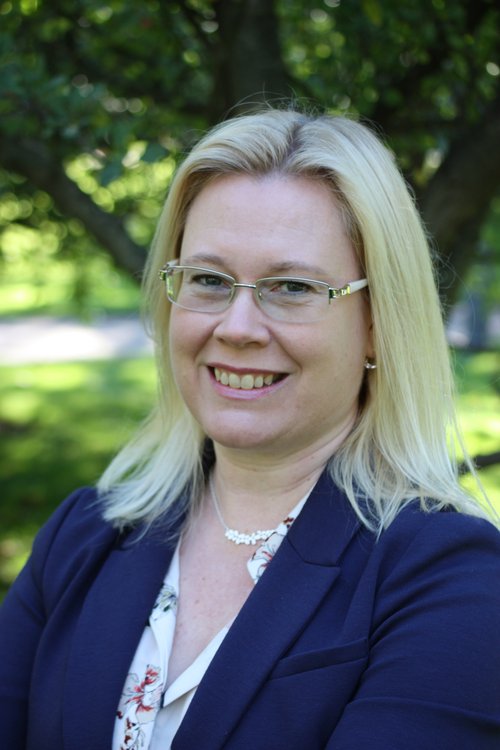Minority language media and the COVID-19 pandemic – the case of Swedish in Finland: An Interview with Dr. Jenny Stenberg-Sirén.





A series edited and conceptualised by Dr. Sergiusz Bober and Craig Willis.
The seventh interview in our ongoing series sees Dr. Jenny Stenberg-Sirén detailing the case of Swedish in Finland. With vast experience as an academic and a journalist, Dr. Stenberg-Sirén is able to provide an extensive analysis of the Swedish language media in Finland, which includes national public TV and radio, as well as a large array of daily newspapers. Audience figures have been seen to increase, including from neighbouring Sweden, and initially bilingual government briefings helped increase the visibility of Swedish among Finnish-speaking majority. At the same time, detailed official information concerning the pandemic not always has been provided on time by the authorities. Moreover, there have been concerns of falling advertising revenue by up to 30% for some newspapers, consistent with the trend we have been observing across MLM in Europe.
Following our regular structure, the interview begins with an overview of Swedish language media across Finland – detailing both the national and regional aspects, including on the autonomous Åland Islands.
As an introduction, could you please summarise the minority language media (MLM) situation in your linguistic sphere?
The Swedish-language media situation in Finland is relatively good, considering the size of the Swedish-speaking population. In 2019, the official number of people with Swedish as their registered mother tongue was 5.2% of the population (approx. 288,000 Swedish, 4,823,000 Finnish, 2,000 Sámi, 413,000 other languages).
The Swedish-language media situation in Finland has historical as well as legislative aspects.
Firstly, since Swedish is a national language in Finland (as well as Finnish), public service media content in Swedish is guaranteed by law. The Act on the Finnish Broadcasting Company states that the Finnish Broadcasting Company Yle should “treat in its broadcasting Finnish-speaking and Swedish-speaking citizens on equal grounds and produce services in the Sami, Romany and sign language and, where applicable, also in the languages of other language groups in the country”. The paragraph clearly separates Swedish from other less spoken languages in Finland, and in this sense makes it more equal to the majority language Finnish.
Naturally, the public service content in Finnish is more extensive than in Swedish; nevertheless, the Swedish-language programming is considerable and it is organised in a separate department, “Swedish Yle”. There are two radio channels in Swedish: Yle Vega, a traditional full service radio channel, including news and regional content, and Yle X3M, aimed at a younger audience. In addition, the television channel Yle Fem broadcasts Swedish-language television programs in a channel slot shared with the Finnish-language channel Yle Teema, featuring culture and science programs. Last but definitely not least, the most important online services are also produced in Swedish, as well as content for mobile apps and social media. All audio and video content can be found on Yle Arenan and the news and other text-based content on the company’s homepage in Swedish.
Secondly, heritage partly explains the considerable number of media outlets in Swedish. Historically, Swedish was the language of the ruling class, used in courts, the church and universities, and the tradition of Swedish-language culture and literature is strong. Today, there are nine newspapers in Swedish in Finland. All the papers are private, and several of them are owned by foundations. Their main sources of income are subscriptions and advertisements. The number of subscriptions for all newspapers in Finland can be studied here. Several of the Swedish-language newspapers are part of the European Association of Daily Newspapers in Minority and Regional Languages (MIDAS).
The major newspaper in the capital region is Hufvudstadsbladet, with about 30,000 subscriptions (print + digital). This is the only national daily newspaper in Swedish in Finland. Hufvudstadsbladet is owned by KSF Media, which also owns the two regional newspapers Västra Nyland and Östnyland, both with two issues per week, and about 5,500-6,000 subscriptions each.
In Ostrobothnia on the west coast, the major regional newspaper is Vasabladet, with six issues per week and about 15,500 subscriptions. Belonging to the same publisher, HSS Media, is Österbottens Tidning, which also has six issues per week, and almost as many subscriptions (11,500), and the smaller newspaper Syd-Österbotten, with three issues per week and about 5,300 subscriptions.
In Åbo/Turku the Swedish-language newspaper is Åbo Underrättelser, with five issues per week, and about 5,500 subscriptions. On the Åland islands, with about 30,000 inhabitants, the media situation is exceptionally good. There are two newspapers, Ålandstidningen with six issues per week and Nya Åland with five issues per week. The third media company is the public service company Ålands Radio & TV, with a radio channel and a television channel focusing on local issues. The media outlets on Åland are not part of the national media audit.
In addition, there is a Swedish-language news agency, Nyhetsbyrån SPT, serving the Swedish-language newspapers. SPT is funded mainly by state funds for minority language support. As part of the same organization as SPT, there is also Mediespråk, a website with language advice for the Swedish-language media in Finland. The site is maintained by the language planners working on site in the media companies.
How has the COVID-19 pandemic affected the reporting of the MLM in your area and has there been any effect on readership / viewing figures?
Naturally, the pandemic dominated news reporting throughout Spring of this year, with much focus on statistics of the number of infected, hospitalized and deceased. Daily reports were given about the situation in Finland, and frequent reports about the numbers in the other Nordic countries, especially Sweden, and the rest of the world.
From the very beginning of the pandemic, private newspapers also made their articles on COVID-19 available for free online. Naturally, the readership figures rose. Both Yle and Hufvudstadsbladet have reported a significant increase in online readers. The paper also reports an increase in digital subscriptions, even though not in print subscriptions.
However, for many newspapers, the number of advertisements has declined, due to the tough economic situation, and several Finnish language newspapers nationwide have resorted to furloughing or laying off staff, even though the MLM have managed quite well so far. According to Hufvudstadsbladet’s Editor in Chief, Susanna Landor, the drop in advertisements is between 30 and 50% for the newspapers in general in Finland, but for Hufvudstadsbladet about 25%.
How has the lockdown / social distancing measures affected other covered content in MLM?
Since sports events and cultural events were more or less banned overnight, this was naturally reflected in the media content. For instance, the sports news are more concentrated on background stories and interviews (for example, Sportliv – a series which interviewed athletes). In the culture section, one can see a shift towards more stories about literature, art, and movies and series from Netflix, HBO and the like. Yle also reports an increased demand for their content through their online streaming service Yle Arenan.
How has MLM covered issues of majority-minority relations and has the situation or voice of minorities been covered in majority media?
In March, the government started giving press briefings regularly. They were broadcast live by most media, streamed online and many news outlets published text based live reports. The press briefings were led by Prime Minister Sanna Marin, who was accompanied by different ministers. As it happens, two of our top ministers at this time are Swedish-speakers: the Minister of Justice, Anna-Maja Henriksson and the Minister of Education, Li Andersson. During the first press briefings, they gave their statements in both Finnish and Swedish and also summarized the main messages of the other ministers in Swedish. Since the press briefings were broadcast live on national television channels and online, this practice brought the less spoken language into the national arena and illustrated the bilingualism of Finland in a concrete way, which is usually the role of the MLM.
However, after a few weeks, the practice changed and the government started using simultaneous interpretation into Swedish instead. Even though interpretation have not always been available for all press briefings, Swedish Yle broadcasts them all. According to Alex Fager, Head of Strategy at Swedish Yle, a reporter translates and summarizes the statements in live subtitles if interpretation is not available. In a way, simultaneous interpretation means an improved service for the minority language, but at the same time, it hides the minority language from the majority. This is an example of the complex processes of language policy, where the good of the individual is not necessarily the best for the language group on a political level.
The pandemic has highlighted the important, but partly conflicted role for the PSM. Being a public service company, Yle has the obligation to broadcast official statements under exceptional circumstances, in Swedish as well. However, journalists also have the obligation to scrutinize the decision makers, which many of the media companies failed to do during the first months of the pandemic. Considering the serious restrictions that were imposed, for example closing off the southern part of Finland (Nyland/Uusimaa) from the rest of the country for a few weeks in order to stop the spread of the virus, the media did not question the legality of the decisions enough. There has also been confusion about which restrictions have been only recommendations and which have been regulations, and the Office of the Parliamentary Ombudsman has received many complaints about the restrictions. The exceptional situation probably caught the journalists off guard, and it took them a few months to get back to their usual roles. In case of a prolonged pandemic, one can expect a better balance between transmitting the official information and scrutinizing it.
There has certainly not been enough information in all the less spoken languages in Finland, but I would like to mention the services for people with hearing impairment. The government’s press briefings had simultaneous interpretation into Finnish sign language, and Swedish Yle made an information video about the recommendations in Finland-Swedish sign language. This illustrates the need for public service media, with their mission to serve minority groups.
There has been some controversy over how well the official institutions have managed to serve the Swedish-speaking population. For example, the information from the Finnish Institute for Health and Welfare has not always been up to date in Swedish, the same goes for the Customs and the Finnish Border Guard. The Swedish-language media also reported on the state owned airline Finnair, which gave information about the pandemic only in Finnish and English. The importance of accurate, up-to-date information in one’s own language in a situation like this has been emphasized. This has strengthened the need for minority language media.
One final aspect that has stood out during the pandemic is the focus on Sweden. News from Sweden is always covered in the Swedish-language media in Finland, and now more than ever. Since Sweden’s way of handling the situation has deviated from the strategies of the other Nordic countries, also the Finnish-language media have reported more frequently on news from Sweden. The traffic of goods as well as people is usually lively between Finland and Sweden, and especially the Åland islands are dependent on the ferries cruising between our countries. The lack of tourists from Sweden has been especially hard for the local economy there. Since Finland closed the border to Sweden, there has been an intense debate about the relationship between our countries. Considering the status and vitality of Swedish in Finland, a close relationship is of great importance.
In what way has the pandemic affected MLM practitioners’ day to day work and have there been any future implications discussed?
The outbreak naturally changed the practices and routines for the MLM. Most journalists have been working from home, and they have found new ways of doing things. Yle has found ways to operate streaming studios remotely, even though radio broadcasting still demands technical staff on site. However, with assistance of studio staff on site, journalists have been able to broadcast from home, and personally, I participated in a live debate on efforts to renew the strategy on the national languages from my kitchen table through a WhatsApp call. Some of these new technical solutions will live on, making the work of the journalists more flexible.
In the media houses, resources were concentrated to news production, and for example sports journalists were transferred to the news department. In Yle, program teams were split in half, and they worked in different buildings or on different floors, in order to ensure enough staff in every section.
How has social media in minority language played a role during the pandemic?
Several Facebook groups relating to the pandemic were started during the spring. Examples include: a group called Corona kitchen, where people can share recipes and food tips; a group about home schooling, for the time when the schools were closed; and a group called “Practical tips for the Swedish part of Finland with Corona around” with about 8,000 followers. This last group was started by journalists from Yle, even though it is not an official Yle-group. In other words, many of the groups focus on practical issues, tips and ways to tackle the unusual situation.
One can clearly see an increase in audience engagement on the social media channels of Swedish Yle and the newspapers. The number of comments have increased, and especially on Hufvudstadsbladet’s Facebook page a considerable amount of people commenting reside in Sweden. We do not know if they have a connection to Finland, but it will be interesting to see if they continue to read news in Swedish from Finland after the pandemic is over as well.
Are there any other points, observations, or impressions of relevance for MLM in the context of COVID-19 you would like to share?
One issue worth mentioning is how the pandemic was handled in journalism education. In the Swedish School of Social Science at the University of Helsinki, where I teach Journalism, we were about to start the yearly production period when the pandemic hit us. During the production period, all students of Journalism and Communication work together as an editorial team, producing news for the web, social media, and radio, as well as a print magazine and a weekly radio show. Overnight we had to rethink the entire concept, and move it online. It went surprisingly well, and the students adapted quickly to the situation. We held editorial meetings through Zoom several times a day, the reporters worked from home, the radio show became a podcast instead, and the radio news was broadcast from the students’ homes, via Zoom to our studio, where our technical staff streamed them on the website. It was a learning opportunity for all involved.
About the author:
Dr. Jenny Stenberg-Sirén’s areas of research combine media and language. Her current research project focuses on the language practices of adolescents in social media. Presently, she holds a research position at the Society of Swedish Literature in Finland. Previously, she has worked as a researcher at the Finland-Swedish think tank Magma, as Senior Lecturer in Journalism at the Swedish School of Social Science at the University of Helsinki, and as Lecturer in Swedish at the Department for Nordic Languages at the University of Helsinki. Her doctoral dissertation analyses the spoken standard language in the Finland-Swedish radio and television news. Before switching to Academia, she worked at the Finnish Broadcasting Company Yle for 12 years as a news reporter, news editor and as Head of New Media.





